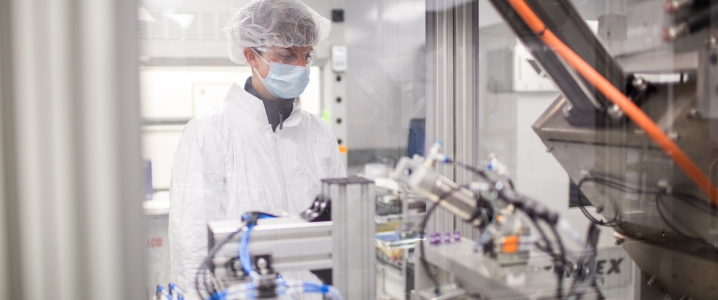Battery maker 24M just received funding for its SemiSolid lithium-ion battery that could have Tesla and other electric carmakers beat in energy storage and electric vehicle driving range.
The company, made up of Massachusetts Institute of Technology (MIT) scientists and a former A123 Systems co-founder, secured nearly $22 million that will take the battery pack to a commercial plant next year with delivery of batteries available in 2020. That funding goes to battery technology with more energy density and storage capacity than what Tesla offers.
Headquartered in Cambridge, Mass., a few blocks away from MIT, 24M brought in two Japanese companies to lead the funding round. That backing comes from ceramics and electronics giant Kyocera Group and Itochu, a textiles and trading business.
Tesla’s electric vehicles use battery technology that carries electrode current into and out of a battery cell. They’re arranged in a series of layers that become wound up into what auto engineers call a jelly roll. The way 24M’s battery varies is that it uses different materials that are four-to-five times thicker than what Tesla and other automakers offer. The SemiSolid can immediately pair up the anodes and cathodes together in a cell.
This will speed up the manufacturing process by cutting out a number of steps typically used in EV battery production. Li-ion batteries typically go through a multistep process that involves mixing, coating, drying, and recovering a solvent that eventually fills the battery with electrolyte. 24M’s battery uses the electrolyte as the solvent to deposit that ingredient onto both sides of the battery, cutting out the typical time and cost needed for production.
It also cuts down the need for inactive materials such as copper, aluminum, and plastics. That will bring down the battery’s costs and the amount of energy needed to charge it up. The company’s process also helps guarantee that more of the electrodes go to storing energy — helping 24M enter another profitable market segment that Tesla thrives in through its Tesla Energy unit. Related: Shale Under Pressure As Oil Falls Below $50
The current version of 24M’s batteries have energy density between 280 and 300 watt-hours per kilogram (Wh/kg). That’s beyond the 250 Wh/kg available to car buyers willing to pay for high-end battery pack options on competitors’ EV models.
The company says its already demonstrated in the lab that its 350 Wh/kg version is feasible. The 24M engineering design team is on a path to building lithium-ion batteries capable of reaching energy density close to 500 Wh/kg, which is double the best of what’s on the market today.
The target market for the SemiSolid battery technology is EVs, promising longer EV driving range, lower battery cost, and faster manufacturing time. The company is also targeting the grid energy storage market, which would help customers better harness wind and solar power. That puts them in line to compete with Tesla Energy, Daimler, BMW, Renault, Nissan, and other automakers.
These and other companies are aggressively pushing toward batteries that will increase higher energy density. That may include alternative electrode chemistries and solid electrolytes.
Solid-state batteries is taking the lead in next generation li-ion batteries coming from Toyota, Volkswagen, Fisker, Hyundai, BMW, and others. VW is working with supplier QuantumScape to produce EV batteries going from the present 300 kilometers (186.4 miles) in the E-Golf up to 750 kilometers (466 miles) that would lead the market in range. The German automaker put $100 million into QuantumScape for a battery joint venture company with the solid-state battery startup.
VW is betting that its cell energy density will increase nearly a quarter between 2018 and 2025. That comes from higher nickel content and eventually from a higher-voltage electrolyte. Investing in the new battery technology is essential for the German automaker’s ambitious EV product lineup coming out by 2025 — in order for car buyers to take them seriously and make the purchase. Related: California To Electrify All Buses By 2029
Another market trend impacting the future of EV batteries comes from reducing cobalt. That goes back to controversy of having to secure cobalt from the Democratic Republic of Congo, a country that has been under pressure for years to stop using child labor for mining cobalt. Tesla has been working on reducing the amount of cobalt going into its battery packs and PowerWalls for energy storage. The company says its batteries contain less than 3 percent cobalt, which is less than leading manufacturers in Asia are targeting for the future.
Daimler has been working to get away from higher cobalt prices by building in a higher ratio of nickel into the battery packs. Daimler and competitors have been researching a new ratio with a mix of nickel cobalt and manganese in their batteries.
The company sees NMC, lithium nickel manganese cobalt oxide, as a very competitive route to go. Panasonic and its customer Tesla are using NCA, or lithium nickel cobalt aluminum oxide; while Nissan and LG Chem are using LMO, or lithium manganese oxide. Chinese manufacturers are trying out a composition called LFP that offers lower energy density without cobalt.
Korean manufacturer LG Chem is continuing to play a competitive role in the li-ion market. One of its top customers is General Motors and its Chevrolet Bolt electric car, which is competing directly with the popular Tesla Model 3. The LG Chem battery cells are using NMC, with the next generation, NMC 811, promising to extend the range on the Bolt. Currently, the Bolt’s battery pack weighs 960 lbs (435 kg), a bit less than the Model 3.
The race is on to find the leading battery technology that will be integral in EVs reaching mass-market sales.
By Jon LeSage for Oilprice.com
More Top Reads From Oilprice.com:
- Saudi Oil Minister: Crude Stocks Should Drop Very Soon
- What’s Behind The Crash In Crude?
- Libyan Oil In Jeopardy As Peace Talks Fail

















